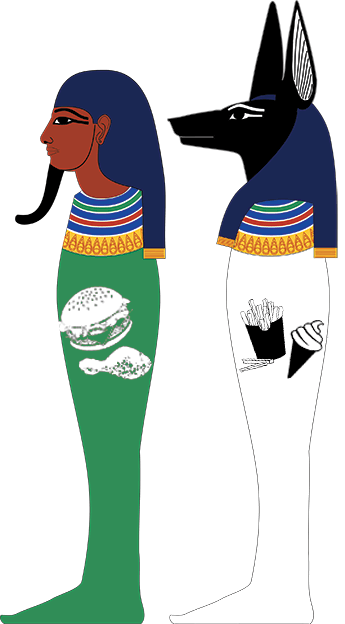Mummies are an obvious and tempting target for organic residue analysis. And, over the years, Richard Evershed, professor of biogeochemistry at the University of Bristol, UK, has published several papers that add to the known chemistry of mummification and thus the trends of the process. But his most recent research focuses on something a little more unusual: meat mummies (1).
Research interest in mummies follows a natural hierarchy. Humans, unsurprisingly, come first. Animal mummies – pets for the dead - were produced in the millions, and so have also been extensively studied. Food mummies, on the other hand, have patiently awaited their chance in the research spotlight. Some foods, such as fruits, seeds and bread, are relatively common in tombs because they survive simply through desiccation rather than complex mummification. “Meat offers a different challenge. We wanted to see if the mummification processes for humans and animals were replicated. Unfortunately, meat mummies tend only to be found in high status tombs, which means they’re rare and somewhat precious,” says Evershed.

Only 40 boxes of mummified food were found in Tutankhamun’s tomb – perhaps the most popular of all mummies (now even more famous given recent findings on the religious reasons behind his erectly embalmed appendage). And while Evershed couldn’t get his hands on King Tut’s tasty treats, he was able to secure samples from the tombs of Yuya and Tjuiu (1386–1349 BC), the parents of Queen Tiye (wife of Pharaoh Amenhotep III, if we’re name dropping). Evershed analyzed the samples with his usual armory of techniques and used isotope analysis to identify the origin of fat residues. “We are dealing with very precious samples; we keep manipulation to a minimum and work at the microscale,” says Evershed. The extracts were trimethylsilylated and injected through a high-temperature GC system with a thin-film (non-polar) column. “This setup allows us to take a look at the full range of compounds, from fatty acids up to high molecular weight waxes.”
Evershed’s biggest surprise was a package identified by X-ray in Cairo to contain part of a rack of beef ribs. “We were lucky to receive some of the bandaging, which had a lot of organic balm applied. When extracted and analyzed by GC-MS, the major compounds were found to be fatty acids,” says Evershed. “Wax esters – possibly derived from bees wax – were also present. But the real surprise was the distinctive triterpenoids, which point to a source in the pistachio tree. This is a resin that was certainly known in the Mediterranean in those times, and there’s evidence of it being traded around, but it’s very rarely been found in mummies.” In fact, Evershed’s balm pre-dates previously recorded use of the pistachia balm by about 700 years. The limited use of the balm, perhaps only in higher status tombs, indicates its exotic nature; indeed, very few high status mummies have been analyzed in this way – most of them are still kept under wraps (pun intended) in Egypt.
The recent research adds to a growing body of data that helps gain a deeper understanding about the evolution of the embalming process. It also forms part of a “bigger picture”; Evershed’s group has been active in the field of archaeological organic residue analysis since the 1980s. “That was when people started to develop more of a realization that, if you applied organic chemistry using modern analytical methods, such as GC-MS, you could identify molecules that, in turn, allowed insight into some of the more intractable materials found at archaeological sites.” “The use of analytical chemistry adds many more pieces to the archaeological puzzle – pieces that other archaeological methods, like staring down a microscope, simply cannot provide,” concludes Evershed.
References
- K. A. Clarka, S. Ikram, and R. P. Evershed, “Organic chemistry of balms used in the preparation of pharaonic meat mummies”, Proc. Natl. Acad. Sci., 110 (51), 20352-20353 (2013). DOI: 10.1073/pnas.1315160110.




